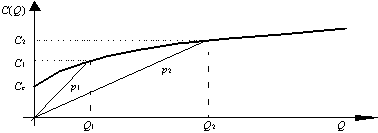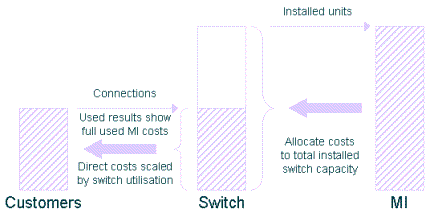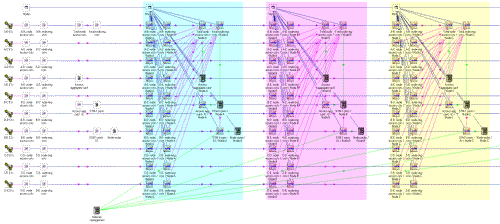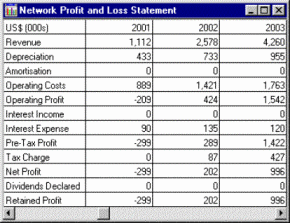 We are pleased
to announce a forthcoming version 7.0 of the STEM modelling system. This milestone
development, planned for release in September 2003, will embrace a new depth of
analysis, including intrinsic support for data services, a range of new financial
calculations, and the addition of Service results broken down by individual Resources.
Clarity is the focus of this update, enhanced by new formatting options in both
the Editor and Result programs, which we plan to preview at the STEM User Group
in September.
We are pleased
to announce a forthcoming version 7.0 of the STEM modelling system. This milestone
development, planned for release in September 2003, will embrace a new depth of
analysis, including intrinsic support for data services, a range of new financial
calculations, and the addition of Service results broken down by individual Resources.
Clarity is the focus of this update, enhanced by new formatting options in both
the Editor and Result programs, which we plan to preview at the STEM User Group
in September.
Intrinsic support for bandwidth services
The traditional Service traffic model is presented according to a methodology designed
for voice services: starting with the annual volume of calls per subscriber and
then estimating the proportion of traffic in the busy hour. While this can and regularly
has been applied to data services by expert users confident to link nominal bit-rate
and contention ratios from User Data, the procedure has been far from intuitive.
STEM 7.0 will offer explicit inputs to capture nominal data rates and contention
ratios as an alternative to the current, voice-orientated formalism. Here the traffic
‘volume’, e.g. megabytes downloaded in a year, becomes a calculated quantity rather
than an input. A new peak bandwidth basis for access ‘pipe’ Requirements may be
desirable, where one would currently rely on Connections mapping onto a unit capacity
for access Resources.
One reason for not introducing this alternative model sooner has been a lack of
consensus as to a standard description of a data service. We welcome your suggestions!
Streamlined capital costs and economies of scale
By popular demand, users will be allowed to enter unit cost inputs for Resources
directly as time series, avoiding the need to pre-process such data when available.
The separate cost trend-mechanism will be maintained for the many occasions when
all you know is the cost ‘now’, and an inline trend will be added for capital costs,
making Cost Indices optional.

The original STEM paradigm for annual economies of scale was an idealised text-book
representation of how unit prices vary according to current production or purchase.
As an academic model, this was fine, but the single logarithmic parameterisation
is unrealistic and inflexible, and bears no relation to typical vendor price structures.
This model will be discarded in favour of a more intuitive Interpolated Series model,
allowing the user to type in a series of price breakpoints directly. (Interpolation
will probably be optional.)

Unit cost falls as number purchased increases (Source: STEM 6.2 manual)
The investment funding model will also be extended to accommodate specific loan
schedules. By default, all long-term borrowing is assumed to come from the same
lender, and on flexible repayment terms. This extension will allow you to capture
the terms of individual loans or bonds, and to measure the impact of higher-interest
costs when deviating from pre-arranged financing limits.
Detailed breakdown of allocated Service costs by Resource
As first publicised in the July 2002 STEM newsletter, and demonstrated in prototype
at the STEM User Group in September 2002, we have been working for some time on
a range of new cost-allocation features. The optional generation of allocated Service
cost results, broken down by individual originating Resources, will provide unprecedented
insight into the economics of service provision, highlighting areas where cost reductions
would be most effective.
These results will be available for all Resources directly or indirectly required
by a Service, or by a Transformation. In addition, we may also produce a breakdown
of sub-total allocations for each Resource directly required by the Service.
In order to limit the potential explosion of data (and disk space), it will be possible
to use additional Service elements to delineate separate network layers. This cross-charging
extension of the existing value-chain mechanism will allow a Service to pass back
total costs to a Transformation input, presenting a single heading for all costs
from a secondary layer when examining the breakdown of costs allocated to a primary
Service.

Determining the scope for Service cost breakdown by Resource
Cost breakdowns will be available for all cost attributes, such as capex, depreciation
and maintenance, and broken down into used and slack components for Services. (Only
used cost results are available for Transformations.) We will also introduce the
concept of direct cost results which are designed to reflect the cost of providing
a Service in a fully efficient network. These are comparable to used cost results
– paying for only the used capacity of equipment – but with an additional adjustment
to allow for secondary demand driven from the installed capacity of non-fully utilised
equipment.

Management interface (MI) used and direct costs compared
These cost-allocation topics are explained in more detail in the article
How does cost allocation work? in the July 2002 newsletter.
Enhanced formatting options
The STEM 7.0 Editor will feature fully zoomable views, allowing you to control the
scale and scope of model structure displayed in individual views. In addition, an
optional colour setting for Collections (and perhaps Variants) will allow you to
highlight groups of related elements more clearly, especially in models which use
Template replication.

Again by popular demand, the Results program will show clear orders of magnitude
for graph and table units with an automatically selected multiplier (in steps of
1000) appended to the relevant unit label, e.g. USD (000s). The trigger level will
be configurable, as will the style, such as ‘000s’, ‘Thousands’, or ‘Milles’. Combined
with the automatic selection of fixed decimal formatting in tables according to
the composite scale of results shown, the intention is to achieve a much more professional
presentation.
